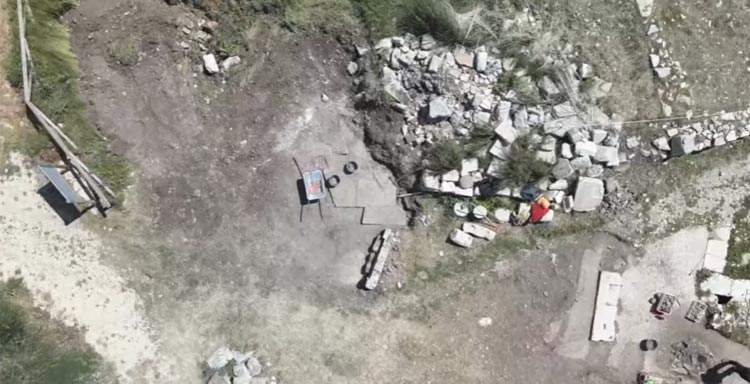Sicily’s three-thousand-year-old history continues to amaze: an “exceptional” discovery has been made in Segesta , to use the discoverers’ own words, namely the flagstones of the ancient road that was used until the Middle Ages and that could thus allow us to identify the paved road that cut through the city. Making the announcement is the Sicily Region’s Department of Cultural Heritage and Sicilian Identity.
The archaeological park that today includes the famous Doric-style temple and a theater from the Hellenistic period, partly excavated in the rock of the hill, among the best preserved in all of Sicily, could now be enriched by what was once theagora. Indeed, at the regional department they are convinced that the road “continues far beyond and could lead to an agora. Around and on it, topsoil has accumulated, which is easily removed.” This discovery, reads a note, “will allow to rewrite the extent of the settlement of Hellenistic age, but already in the Roman orbit, in activity until the medieval period, as denounced by important (and beautiful) fragments of pottery. But archaeologists are hoping for more: they sense the road.”
Also working at the site, in support of technicians and experts, are young asylum seekers from the Casa Belvedere center in Marsala, which has entered into a solidarity archaeology agreement with the Segesta Park and theUniversity of Geneva, which is conducting the excavation that led to the discovery.
It was just two years ago that another major discovery was made at the site after it had been open for almost thirty years (1992): an important pavement (the only one of its kind) with an ancient illusory game of three-color rhomboidal tesserae, marble “sectilia” (white, light blue and dark green) depicting a concatenated sequence of cubes with a three-dimensional effect. A vision very reminiscent of the Impossible Worlds created in the late 19th century by Escher. But also two stone shelves in the shape of a prow and a welcome inscription: it was these findings that have so far led archaeologists to speculate that this was the home of the navarch Heraclius, a very wealthy shipowner mentioned by Cicero in the Verrines. The house must have been a sort of lookout site-as evidenced by a medieval tower that insists on the dwelling’s peristyle atrium-since from up here the view reaches as far as present-day Castellammare.
But it is a hypothesis of which archaeologists, above all excavation director Alessia Mistretta and Emanuele Canzonieri, are not convinced. Of the House of the Navarch they are not satisfied, because their intent is not only to bring to light other rooms of this monumental complex, but above all to understand its function. The discovery of the bows, in fact, according to scholars indicates the probable function of only one of the rooms, which must have been very large and with mosaic floors of great value: as a working hypothesis they are, instead, oriented toward an archive in which documents, routes, and maps about the port that Segesta possessed were kept, presided over by a quaestor navalis whose identity is known. But the excavation goes on, and one waits to see what it will lead to.
The long-range goal enters the deepest folds of the Park and aims to draw a new tour itinerary in Segesta on the symbols of the sacred (which is together places, rituals, religions, traditions, architectures), starting with the mosque, the imposing Doric temple and the small church of San Leone, an interesting stratified site of earlier civilizations. St. Leo’s was built in 1442 on a pre-existing Norman-Swabian church of the late 12th century, which in turn stands on a Hellenistic-era building (between the 2nd and 1st centuries BC) whose mosaics - brought back to view these days after heavy clearing - were later reused as the floor of the two later churches.
Finally, the management of the Segesta Archaeological Park informs that as early as April 25, guided tours of the open site will also be possible, with the support of the concessionaire of additional services, CoopCulture.
 |
| Important discovery in Segesta: slabs of the ancient street that cut through the city found |
Warning: the translation into English of the original Italian article was created using automatic tools. We undertake to review all articles, but we do not guarantee the total absence of inaccuracies in the translation due to the program. You can find the original by clicking on the ITA button. If you find any mistake,please contact us.